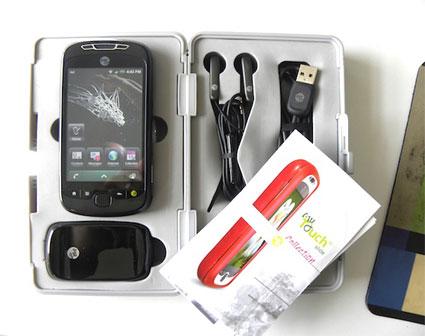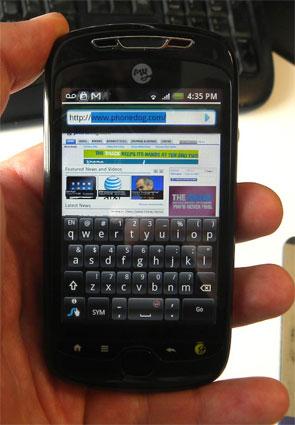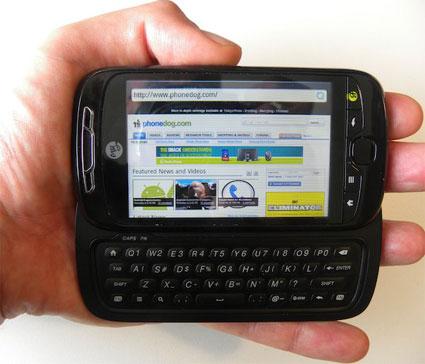
What's Good: Solid Android performance plus highly customized user interface; Great hard QWERTY board; Genius Button and myModes offer exclusive functionality; T-Mobile offers great value on monthly voice/data plans.
What's Bad: Smaller display and lesser specs compared to other flagship Android devices; Custom UI arguably less appealing than stock Android; Build quality issues with our review unit.
Verdict: Forget the spec sheet, myTouch 3G Slide is the rare Android phone that features a solid hard keyboard. On top of that, you get HTC Sense and some extra features unique to T-Mobile. Slide is a little bulky, but still a worthy high-end Android device and a nice upgrade for former Sidekick users wanting a true smartphone.

T-Mobile's new flagship device bucks the trend towards thin, touch-only devices sporting larger and larger displays: The HTC-built myTouch 3G Slide not only sports a horizontally-sliding QWERTY keyboard, but its display is "only" 3.4" diagonal, noticeably smaller than Verizon's Droid Incredible (3.7") and positively tiny next to Sprint's Evo 4G (4.3"). So while Slide is thicker and heavier than its Android brethren, it also offers the value add of an actual keyboard with actual buttons. Beyond that, T-Mobile has loaded this baby to the gills with customized software and exclusive features designed to offer a smarter, more personal smartphone experience - which is saying something considering how customizable stock Android and "stock" HTC Sense already are.

myTouch 3G Slide takes its design cues from the previous myTouch devices, though it's a bit more angular than the myTouch 3G that most recently preceded it. Slide is available in black, red, and white, and T-Mobile sent me the black version for review - it's black and glossy with a somewhat odd chrome plastic trim around the earpiece that reminds me of the grill on a car that's trying to look sporty and muscular. While Slide's chrome accents aren't that big of a deal to me, I could definitely do without them, aesthetically speaking.
The phone measures in at 116 x 60 x 15.2 mm and weighs 164 grams, slotting it in between the LG Ally and Motorola Droid, two other side-sliding Android phones. Looked at differently, Slide is thinner but otherwise larger and heavier than the original G1, but quite a bit smaller than the most recent Sidekick, the LX. The phone's 3.4" capacitive display is multitouch capable TFT LCD panel with a resolution of 320 x 480 pixels (HVGA), and the screen is flanked on the bottom by four buttons and a clickable optical D-Pad. Slide the display panel up and you'll find a four-row hard QWERTY board modeled after HTC's superlative Touch Pro2 keyboard. You'll also find a dedicated camera button and rocker switch for volume on the sides of the device, and 3.5mm audio and microUSB ports on the top and bottom, respectively.
One note about that sliding display panel: Mine wobbles. When the panel is fully extended on my review unit, the upper (screen) portion wiggles more than it should. I asked T-Mobile about this and I asked some other reviewers I know about this and none of them said they'd had the same experience. So I'll chalk it up to a bad apple in the bunch. Hopefully when Slides start hitting the stores, this won't be a recurring problem. What does seem like a recurring, if minor, problem is that the slide action isn't the smoothest I (and the others I've talked to) have ever encountered. While the snap action on the slide is true and solid, the slide itself is kind of gritty, as though two pieces of plastic are rubbing a bit too hard on one another instead of gliding smoothly on by as they should be.

Slide's backside sports a 5 megapixel camera that's paired with an LED flash. The camera features autofocus and also captures VGA video with sound. Were you to tear the phone apart, you'd find all kinds of chips and circuits dedicated to making the thing run smoothly and connect to the world: There's Quad-Band GSM/EDGE/HSPA 7.2 connectivity for voice and data, WiFi 802.11 b/g, A-GPS and Bluetooth 2.1 + EDR support, and a 600 MHz ARM processor backed by 512 MB each of RAM and ROM to make the whole thing go.
And last but not least, the whole thing comes packed in a plastic Super Agent Man briefcase along with a USB cable, AC charger, stereo headset and a catalog full of all kinds of other myTouch accessories you can pony up for to complete the look. Seriously, the briefcase is a trip, even though it is kind of a waste of resources - what can I say, I'm all about the eco-friendlier packaging lately.


myTouch 3G Slide is entirely unique in that it's not just an Android phone or an Android phone with HTC Sense, but an Android/Sense smartphone with T-Mobile-exclusive extra goodies like Genius, Faves and myModes. No matter how you slice it, though, Slide is a solid performer. It's no Snapdragon superphone, but if you didn't know the difference between ARM and Qualcomm before using the thing, you likely wouldn't care - T-Mo's flagship phone was up to every task I threw at it, even if Sprint's Evo 4G and Verizon's Incredible could perform the same tasks just a little bit faster. One note before we go any further, though: No support for Live Wallpapers. The custom build of Android/Sense doesn't support them, unless there's some hack or workaround I haven't discovered yet. On the positive side, the custom UI features support for landscape-mode home screens, which is a big deal on a phone with a side-sliding keyboard.
As a smartphone, Slide works really well. The touchscreen is bright and responsive, and gestures including swiping multitouch pinching-to-zoom work really well. Android features and software, from the stock Web browser and GMail client to the thousands of apps available for download in the Marketplace, worked just fine on Slide. Voice call quality was solid during my testing in the East Bay region of the San Francisco, CA area and data connectivity was generally solid and fast via both WiFi and T-Mobile's HSPA network. Slide supports HSPA 7.2, so those of you in range of the carrier's recently upgraded HSPA+ network should see some really fast download speeds on the go. Bluetooth connectivity worked just fine, and GPS tracking was on par with other Android devices I've tested recently - plenty good for using the integrated Google Maps and Navigation apps to find my way around town.

Keyboards are a very personal thing, and personally I love Slide's QWERTY. While not quite as luscious as the Touch Pro2 on which it's based, mT3G Slide's thumbboard has been a joy to use save for some minor issues I have with the labels on the keys. Buttons on the keyboard are offset and isolated and have decent travel and solid tactile feel - in other words, its the exact opposite of the Moto Droid's flat grid of near motionless buttons, which I can't stand. If you just read that sentence and wrote off the rest of my review because you love, love, love Droid's QWERTY, then you may well hate Slide's keyboard. Like I said, QWERTYs are a highly personal matter. Slide also comes with the Swype touch input system preinstalled, though I can't imagine opting for a device with a real thumbboard only to then rely on the onscreen keyboard more than once in awhile.
myTouch 3G Slide runs a highly tweaked version of Google's Android platform. T-Mobile and HTC took Android 2.1, added HTC's Sense to it, and then customized the whole thing even more with new icons, an automated modes system similar to - but more advanced than - what Nokia uses on its E-series phones ("myModes"), and a "Genius Button." I'm not so sure that I like what T-Mo and HTC did to Sense's look and feel here, though I understand where they were coming from. Everything has been simplified and brought as close to the surface as possible, seemingly in an effort to make as much advanced functionality accessible to the novice user as possible. Home screen icons have button-like outlines that indicate the entire touchable area. The notifications tray includes a list of recently used app icons for quick access. The apps drawer at the bottom of Home screens swaps the "Add to Home" plus button out in favor of a link to the Faves program, which is a highly visual way to access your most-used contacts and see their Facebook status updates. Personally I don't much care for the look and feel of Faves and kinda wish it had somehow been merged into HTC's Friendstream and/or People apps, which feature much deeper social networking integration.
The Genius Button takes the place of the search button commonly found on Android phones, and it uses Dragon Dictation technology to take voice commands to the next level, adding to Google's already excellent voice recognition for Android phones. While I don't know that many users will see Genius as a must have feature, it does offer both a simplified user interface for guiding novices through the voice command process and the ability to compose text messages hands-free - and hear incoming missives read aloud to you in a synthesized voice. Genius' voice recognition wasn't 100% accurate (not at all), but the feature worked fairly well overall.
And myModes is a multi-theme manager that allows you to set up a rotation of themes (wallpaper + visual style + ringtones + widget and app shortcuts) and then cycle between them either manually or on an automated basis. The automated part is pretty neat, as you can trigger a new theme to activated based on time or location. For example, I set up three themes and called them "Home," "Office," and "Weekend." Home featured a fun wallpaper, an alarm clock widget, and easy access to my personal Email. Office featured a drab wallpaper, access to Work Email, and an RSS feed widget. Weekend was entirely blank save for music and weather widgets. I then set myModes up with Home as my default mode, Office to be triggered when GPS sensed I was near my office, and Weekend to take over from Friday evening until Monday morning. Neato!

There's more, so much more, about myTouch 3G Slide that can't really be covered here (I've already written too much). The 5MP camera is fine for a cameraphone, and VGA video capture is pretty good (check out my Android camcorder shootout for samples). Battery life has been entirely acceptable, with nary a charge needed before bedtime. Bear in mind that the more widgets and apps you run simultaneously on an Android phone - any Android phone - the faster that battery will run down. And audio quality via the speakerphone is pretty good while music pumped out through a good set of earphones sounds just great. THere's even a pre-installed myTouch music app that's some kind of T-Mobile curated Internet radio thingy. I'm going to be honest: The first time I fired it up, it threw some Bieber at me, so I shut it down and never went back.
myTouch has become T-Mobile's signature line of smartphones, featuring highly customizable hardware and now, with myTouch 3G Slide, highly customizable software as well. Whatever you think of T-Mo's work here, there's no denying they've put a lot of thought and effort into giving their customers something beyond stock Android or even the "standard" HTC Sense experience available on their competitors' phones. I'm not entirely in love with the changes to Android/Sense's look and feel found here, and I miss Live Wallpaper support, but Slide still does almost all of what other Android/Sense phones do, and it does it quite well.
Add to that what I think is a great hard QWERTY board and a few pretty interesting exclusive features, and you've got yourself what's arguably the best Android phone with a hard keyboard currently available from a US carrier. Verizon's LG Ally has a nice QWERTY and runs Android 2.1, but it's slower than Slide. Sprint's Samsung Moment suffers from a bizarre keyboard layout and it's quite bulky. And Moto Droid … well like I said, don't even get me started on Droid's QWERTY board.
Sidekick users looking to step up to a smartphone and anyone looking for a good value on a solid Android device should give the myTouch 3G Slide a look. It may not be as thin or fast as the other flagship phones, but it's got a few tricks of its own that just might win you over.